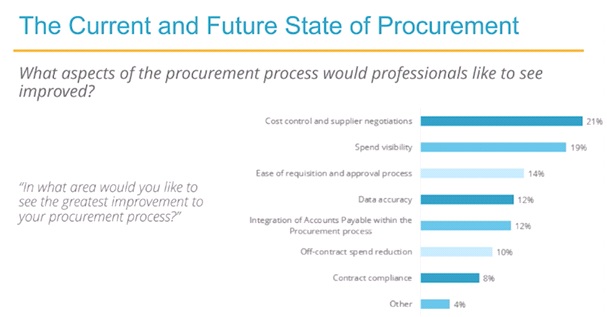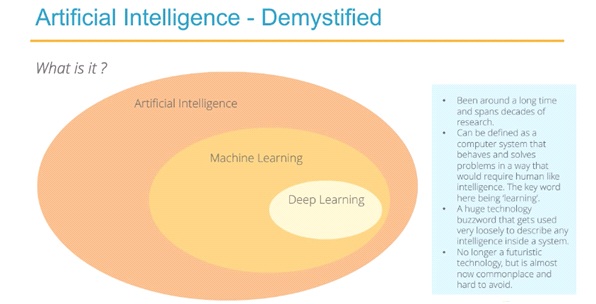- Blog
- Big Data Procurement: How to Leverage Modern Technologies to Gain Control Over Indirect Spend
Big Data Procurement: How to Leverage Modern Technologies to Gain Control Over Indirect Spend
In 2020, modest adoption of procurement and sourcing technology will limit smart machine technology's penetration to 10% of the total available market.1
I recently had the opportunity to co-host a webinar with Anna Barnett, Research Associate with PayStream Advisors and engage in a lively discussion on what procurement professionals need to know about modern technologies like artificial intelligence and machine learning. If you missed the live event, check out the key takeaways from our discussion below.
Modern Procurement Starts with Automation
Automating procurement processes is the first step to being able to leverage modern technologies. According to research by PayStream, 52% of organisations surveyed are already using an e-procurement solution. Those who aren’t yet using it reported a desire to improve their processes, specifically in the areas of cost control and supplier negotiations, spend visibility and ease of requisition and approval processes.

e-Procurement Solutions Solve Procurement Pain Points
While there are many ways that technology can help Procurement contribute more to the organisation, there are four major pain points that e-procurement eases:
-
Poor Supplier Query Response Times — An e-procurement solution solves this problem by shifting the purchasing process to an order management module that gives departments real time visibility into the latest status of orders at any point in the purchasing cycle.
-
Poor Supplier Data Management — An e-procurement solution solves this issue by consolidating all supplier information into a single repository with features like supplier risk management, analytics and reporting tools.
-
Late Payments — An e-procurement solution solves this problem by expediting the entire ordering process and ensuring pre-approved purchasing. This means when the invoice arrives, it gets processed and paid faster.
-
Poor Contract Compliance — An e-procurement solution solves this issue by providing catalogs for users, so they order on-contract items selected by Procurement. Companies may also opt to add a contract lifecycle management(CLM) module. CLM solutions monitor and react to the contracts they store. Contracts are created, tracked and stored within the solution.
Emerging Technologies Are Enhancing e-Procurement Solutions
Today’s most advanced procurement tools are using artificial intelligence (AI), machine learning and deep learning to identify opportunities where companies are missing savings – turning data into a competitive advantage. Let’s look at each of these technologies in depth.

Procurement Becomes More Strategic with AI
First, what is artificial intelligence? This technology can be defined as a computer system that behaves and solves problems without human intervention – enabling humans to focus on more value-add tasks.
Some examples of artificial intelligence include:
-
Google maps — the ability to crowdsource data, crunch through it, and continuously learn to predict, with incredible accuracy, time to destination and traffic hotspots
-
Siri, Google, Cortana, and Alexa — virtual personal assistants
-
Email spam filters
-
Credit card fraud detection
-
Facial recognition, photo classifications
-
Self-driving cars
Procurement can use this technology to greatly reduce manual tasks, freeing time for more important activities. With that free time, Procurement can focus on strategic tasks like right-sizing the supply base, sourcing events, negotiating better contracts, capturing volume discounts, analysing data and more.
Procurement Reaps Visibility and Predictability with Machine Learning and Deep Learning
Machine learning is a set of algorithms that give computers the ability to learn from data and then make recommendations and predictions. Machine learning is strongly related to the field of statistics. Think Amazon’s ability to suggest related products as you’re shopping – that’s machine learning in action. For procurement, machine learning can forecast the number of orders that will be placed in a given month based on past activity.
Deep learning is modeled after neural connections in the human brain that identify and make more abstract predictions. A common example is the ability to recognise objects in a photo. It’s the technology behind natural language processing, such as chatbots. Chatbots are being deployed in B2B systems like purchase-to-pay and e-procurement solutions to enhance and streamline the user interaction and help people find what they need quickly.
Emerging Technologies Are Already Being Used to Improve Procurement
AI and machine learning are not just technologies of the future — software companies are implementing it now, and organisations across a variety of industries are taking advantage of it. And it goes both ways – customers should come to expect software companies to explore and implement emerging technologies that increase visibility and enhance their experience with the solution by making functional tasks easier to complete. One trending example of this is chatbots and virtual assistants.
Chatbots provide effective assistance without the need for human involvement. Through natural language processing and some business-specific rules, many application functions can be fully implemented using a conversational UI.
Chatbots can help procurement professionals in the following ways:
-
Receiving purchase orders
-
Finding what you need quickly (requests, invoices, contracts, etc.)
-
Recreating new order requests from previous requests
-
Searching the catalog and placing a quick order
Here are a few other ways AI can benefit Procurement:
-
Challenge: Companies often exceed budget targets for expenses.
-
Use predictive analysis based on spend trend to forecast budget allocations.
-
Challenge: Multiple orders from the same location and for the same vendor resulting in excess freight costs and missed volume discount opportunities.
-
Solution:Leverage intelligent transaction aggregator based on historical patterns to save on freight costs and send alerts to Procurement about potential volume discounts.
-
Challenge: Approvals and spend rewards take too much time to process.
-
Predict approval times for order requests based on workflows.
-
Challenge: When catalogs are large, users often find it hard to navigate the available options and make purchase decisions.
-
Use popular product recommendations to identify similar, related products for comparison.
-
Challenge: Late payment fees penalise companies.
Solution:Use predictive analytics to identify invoices that will end up getting paid late and flag at the time of creation.
